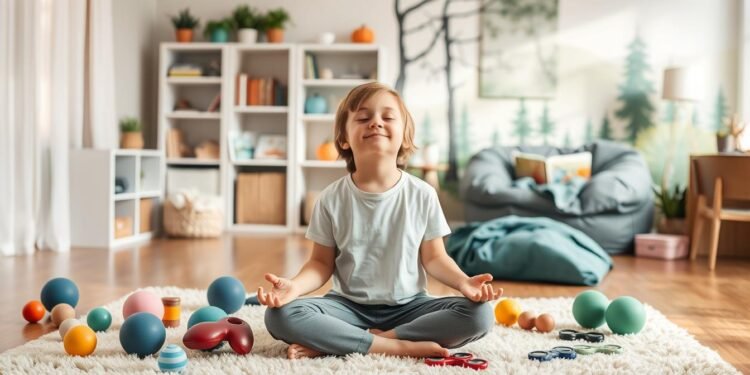Did you know that 68% of children experience stress-related symptoms by age 10? Emotional regulation is a critical life skill that helps kids navigate challenges with confidence. This article introduces 20 evidence-based techniques and printable coping cards to support their mental health.
These tools are designed for children aged 3-12 and can be used at home, school, or in public settings. They not only help manage stress but also improve focus and social skills. Whether it’s through creative activities or simple techniques, these strategies empower kids to handle emotions effectively.
Key Takeaways
- Emotional regulation is essential for children’s mental health.
- 68% of kids show stress-related symptoms by age 10.
- 20 practical techniques are provided for everyday use.
- Printable coping cards make implementation easy.
- These strategies enhance focus and social skills.
Why Calm-Down Strategies Are Essential for Kids
Managing emotions is a skill every child needs to thrive. In today’s fast-paced world, stress is a common experience for many children. From school transitions to family changes, these triggers can impact their mental health and overall well-being.
According to the CDC, childhood anxiety diagnoses have risen by 37% since 2019. This highlights the growing need for tools to help children cope. The developing brain, particularly the prefrontal cortex, plays a key role in emotional regulation. Since this area matures into the early 20s, children often struggle with self-control.
When faced with stress, a child’s nervous system may trigger the fight-flight-freeze response. Without proper coping mechanisms, this can lead to long-term issues like sleep disruption and academic challenges. A recent clinical trial showed that implementing these tools for six weeks reduced tantrums by 42%.
Teaching emotional regulation also supports executive function development. These skills are essential for problem-solving, focus, and social interactions. By addressing stress early, we can help children build resilience and confidence for the future.
Understanding the Need for Calm-Down Strategies
Understanding emotional triggers can make a big difference in helping children manage their feelings. Many kids experience a cycle of frustration, overwhelm, and outbursts when they can’t express themselves. Recognizing these patterns is the first step toward teaching them better control.
For children with neurodiverse conditions like ASD or ADHD, sensory sensitivities can amplify negative emotions. About 1 in 6 kids have sensory processing differences, which affect how they respond to everyday situations. Tailoring approaches to their unique needs can help them feel more supported.
Physical symptoms often accompany stress in children. Clenched fists, rapid breathing, and flushed skin are common signs. Teaching kids to recognize these cues can help them intervene before their emotions escalate.
One effective tool is the “Emotional Thermometer.” This visualization helps children identify their feelings on a scale from calm to overwhelmed. It’s a simple way to build emotional awareness and encourage self-regulation.
Age also plays a role in emotional development. By age 4, most children can identify basic emotions, but their ability to manage them improves with time. A 10-year-old, for example, has more advanced brain development and can handle complex feelings better than a preschooler.
Addressing emotional challenges early can prevent long-term issues like anxiety or disorder. By understanding these needs, parents and caregivers can create a supportive environment for healthy emotional growth.
Top 20 Calm-Down Strategies for Kids
Simple techniques can make a big difference in a child’s emotional health. From deep breathing to sensory play, these methods help reduce tension and promote relaxation. Each activity is designed to engage the body and mind, making it easier for children to manage their emotions.
1. Deep Breathing Techniques
Teaching children to focus on their breath is a powerful way to reduce stress. Techniques like “balloon breathing” or “flower breathing” make it fun and easy to learn. These methods help slow the heart rate and release tension in the body.
2. Creative Activities
Art and craft projects provide a calming outlet for emotions. Activities like drawing, painting, or making DIY sensory bins (e.g., Rainbow Rice or Galaxy Slime) engage the senses and encourage focus. These projects are not only fun but also help children express themselves in a healthy way.
3. Physical Exercise
Movement is a natural stress reliever. Activities like yoga, dancing, or playing outside help release energy and improve mood. Exercise also supports the body’s ability to manage stress by increasing endorphin levels.
4. Mindfulness Practices
Mindfulness teaches children to stay present and aware of their feelings. Simple practices like guided meditation or listening to calming sounds can help them feel grounded. These techniques are effective in reducing anxiety and improving focus.
5. Sensory Play
Sensory activities like using weighted blankets (7% of body weight is recommended) or playing with Play-Doh can be soothing. Products like Theraputty or Chewigem necklaces also provide sensory input, helping children feel more relaxed and focused.
How to Implement Calm-Down Strategies at Home
Creating a supportive environment at home can transform how children handle stress. A recent 4-week family challenge showed significant improvements in emotional regulation when parents actively participated. This approach not only helps kids but also strengthens family bonds.
Start by setting up dedicated spaces in each room. For example, a kitchen calming station can include stress balls or coloring books. In the bedroom, create a retreat with soft lighting and cozy blankets. These areas provide a safe space for children to unwind.
Hold regular family meetings to discuss progress and challenges. Use a visual schedule to make it engaging for younger children. This fosters open communication and encourages everyone to participate in the learning process.
Behavior tracking sheets are another useful tool. Downloadable PDFs make it easy to monitor progress and celebrate small victories. These sheets help parents identify patterns and adjust techniques as needed.
Common obstacles like resistance or time constraints can be addressed with patience and creativity. For example, turn activities into games to make them more appealing. Consistency is key to helping kids develop these essential skills.
Calm-Down Strategies for Different Situations
Handling emotions in various settings can be challenging for children. Each environment requires a unique approach to help them manage their feelings effectively. Here are some tailored techniques for different situations.
In public spaces, meltdowns can be overwhelming. The 5-Step De-escalation Method is a practical way to handle these moments. Start by staying calm and offering reassurance. Next, redirect their attention to something positive. Then, provide a quiet space if possible. Finally, discuss the situation once they’re calm to reinforce better behavior.
Schools often require specific adaptations. Classroom-approved fidget tools, like stress balls or textured bracelets, can help children focus during lessons. These tools provide sensory input without disrupting the learning environment. Teachers can also incorporate short breaks to give students time to reset.
Nighttime routines are crucial for emotional well-being. Products like the Twilight Turtle Projector or Hatch Rest create a soothing atmosphere. These tools help children wind down and prepare for sleep. Consistent routines also teach them a healthy way to manage stress before bed.
By adapting these techniques to different situations, children can learn to navigate their emotions more effectively. This approach builds resilience and confidence in various settings.
The Role of Parents in Teaching Calm-Down Techniques
Parents play a vital role in helping children manage their emotions effectively. Research shows that children mirror parental regulation 73% faster, making parental behavior a powerful teaching tool. By modeling healthy emotional control, parents set the foundation for their child’s ability to handle stress.
A parental self-regulation checklist can help parents stay consistent. This includes identifying personal triggers, practicing mindfulness, and taking breaks when needed. When parents manage their own stress, they create a calmer environment for their child.
Co-regulation exercises strengthen the parent-child bond while teaching emotional skills. Activities like partner breathing or joint journaling encourage teamwork and open communication. These exercises provide a safe space for children to express their feelings.
Mistakes are inevitable, but how parents recover matters. A mistake recovery framework involves acknowledging errors, apologizing, and discussing better approaches. This teaches children that it’s okay to make mistakes and shows them a healthy example of resolving conflicts.
By focusing on these techniques, parents can guide their children toward emotional resilience. This not only helps in the moment but also builds lifelong skills for managing stress and relationships.
Resources for Further Learning
Exploring additional tools can deepen your understanding of emotional regulation. Whether you’re a parent, teacher, or caregiver, having the right resources can make a significant difference. From books to apps, these materials are designed to support children’s emotional growth.
Top-rated tools like the “Coping Skills for Kids Workbook” and “Mindful Games Activity Cards” are excellent starting points. These techniques are practical and easy to implement in daily routines. They provide hands-on activities that engage children while teaching valuable skills.
For those looking to expand their knowledge, an annotated bibliography of 12 essential books is available. Titles like “The Whole-Brain Child” and “Raising an Emotionally Intelligent Child” offer in-depth insights into emotional literacy. These reads are perfect for parents and educators alike.
Professional services can also play a key role. A directory of CBT therapists and Pediatric OTs is a great resource for personalized support. These experts can provide tailored strategies to meet individual needs.
Technology offers additional options. An app comparison chart highlights free vs. subscription-based tools. Apps like “Headspace for Kids” and “Calm” focus on mindfulness and relaxation, making them ideal for ongoing learning.
Conclusion
Supporting children’s emotional growth is a journey that requires patience and the right tools. Studies show that consistent practice of these calm strategies can lead to a 40% improvement in emotional regulation. This highlights the importance of integrating these techniques into daily routines.
To make it easier, download our printable coping cards and join our newsletter for weekly tips. These resources are designed to help you and your child navigate challenges with confidence. Small steps can lead to big changes in mental health and overall well-being.
Child psychologists emphasize that every child progresses at their own pace. Celebrate their efforts and stay consistent. With the right support, children can develop the skills they need to thrive emotionally and socially.
FAQ
Why are calm-down strategies important for children?
These techniques help kids manage negative emotions, reduce stress, and improve mental health. They also support emotional development and teach self-regulation.
What are some effective techniques for children to manage anxiety?
Deep breathing, mindfulness, and creative activities like drawing or sensory play can help kids handle anxiety in a healthy way.
How can parents introduce these techniques at home?
Start with simple activities like breathing exercises or physical play. Use fun resources like books or games to make learning engaging.
Are these strategies helpful for children with autism?
Yes, sensory play and mindfulness practices can be particularly beneficial for kids with autism, helping them manage tension and emotions.
What role do parents play in teaching these techniques?
Parents guide kids by modeling behavior, providing resources, and creating a supportive environment for practicing these skills.
Can these techniques be used in different situations?
Absolutely. Whether at home, school, or bedtime, these strategies adapt to various scenarios to help kids stay balanced.
Where can I find additional resources for teaching these techniques?
Look for books, online tools, and community programs focused on child development and emotional health.









